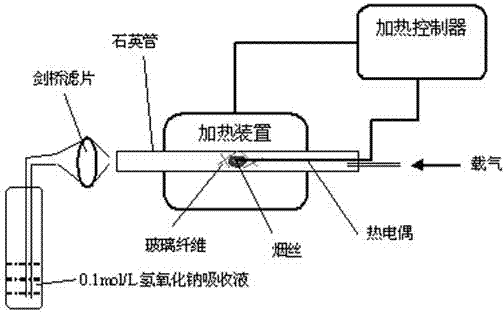Determination method for experiment of simulating cigarette burning for generating hydrogen cyanide
A method for measuring hydrogen cyanide, which is applied in the field of tobacco industry, can solve problems such as slow heating rate, small sample loading capacity of instruments and devices, and single carrier gas atmosphere, and achieve fast heating rate, large sample loading capacity, and experimental repeatability Good results
- Summary
- Abstract
- Description
- Claims
- Application Information
AI Technical Summary
Problems solved by technology
Method used
Image
Examples
example 1
[0016] Weigh 0.1g flue-cured tobacco shreds and put them into the middle of the quartz tube, fill the two ends of the sample with 0.1g glass fiber, then put the quartz tube into the infrared furnace, insert the thermocouple into the sample in the sample tube, set the temperature rise program to 50°C / s, a mixed gas (20% oxygen) with a flow rate of 17.5mL / s is introduced, the power is turned on, and the temperature rises from room temperature to 900°C. .1mol / L sodium hydroxide solution is absorbed, and the Cambridge filter that captures the particulate matter is then shaken and extracted with 20mL0.1mol / L sodium hydroxide solution for 30min. The amount of HCN produced was determined by the method, and the amount of HCN generated by simulated burning and smoking of 0.1g flue-cured tobacco shreds was measured to be 308μg.
[0017]
example 2
[0019] In order to study the HCN precursor components in cut tobacco, experiments are often carried out by simulating the chemical components of cut tobacco (such as protein, cellulose, amino acid, etc.). Weigh 100mg of protein into the middle of the quartz tube, fill the two ends of the sample with 0.1g glass fiber, then put the quartz tube into the infrared furnace, insert the thermocouple into the sample in the sample tube, set the temperature rise program to 100°C / s , the mixed gas (9% oxygen) with a flow rate of 17.5mL / s was introduced, the power was turned on, and the room temperature rose to 900°C. Absorbed in / L sodium hydroxide solution, the Cambridge filter disc that traps the particulate matter is then shaken and extracted with 20mL0.1mol / L sodium hydroxide solution for 30min, and then 5mL of the solution is taken each, and measured by the continuous flow method in YC / T 253-2008 The amount of HCN produced, as a result, the amount of HCN produced by simulated burning...
example 3
[0022] Weigh 0.5g of glycine into the middle of the quartz tube, fill the two ends of the sample with 0.1g of glass fiber, then put the quartz tube into the infrared furnace, insert the thermocouple into the sample in the sample tube, set the temperature rise program to 100°C / s, feed in nitrogen gas with a flow rate of 17.5mL / s, turn on the power, rise from room temperature to 900°C, use a Cambridge filter at the gas outlet to capture the particulate matter in the flue gas, and pass through the gas phase with 20mL of 0.1mol / L sodium hydroxide The solution is absorbed, and the Cambridge filter that captures the particulate matter is then shaken and extracted with 20mL0.1mol / L sodium hydroxide solution for 30min. The amount of HCN produced by simulated smoking of 0.5g of flue-cured tobacco shreds was 17.25mg, indicating that HCN was produced after simulated smoking of glycine, which was the precursor component of HCN in smoke.
PUM
 Login to View More
Login to View More Abstract
Description
Claims
Application Information
 Login to View More
Login to View More - R&D
- Intellectual Property
- Life Sciences
- Materials
- Tech Scout
- Unparalleled Data Quality
- Higher Quality Content
- 60% Fewer Hallucinations
Browse by: Latest US Patents, China's latest patents, Technical Efficacy Thesaurus, Application Domain, Technology Topic, Popular Technical Reports.
© 2025 PatSnap. All rights reserved.Legal|Privacy policy|Modern Slavery Act Transparency Statement|Sitemap|About US| Contact US: help@patsnap.com

